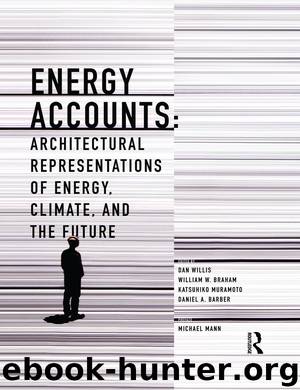Energy Accounts by Michael Mann

Author:Michael Mann [Michael Mann]
Language: eng
Format: epub
ISBN: 9781317428763
Publisher: Taylor and Francis
Building on the PRISM model of Fels (1986) while at Texas A&M, Kelly Kissock developed the LEAN analysis tool for graphically and statistically assigning energy demands to major end uses with as few as 60 data points (Kissock and Seryak 2004). The measured monthly energy use is plotted against outdoor temperature, revealing surges in heating loads as the temperature drops, surges in cooling loads as the temperature rises and critical inflection points where the thermal loads are lowest, revealing base electric and gas loads. The New Buildings Institute has taken this a step further in their FirstView Diagnostic tool and database (Reichmuth and Turner 2010). This tool takes monthly data sets (or daily, hourly, or 15 minute data sets) plotted against outdoor temperature to generate an energy signature. It can then compare that signature to a database of similar buildings and locations to identify energy use anomalies. FirstView can generate automated recommendations for possible energy retrofits – upgrades for heating and cooling equipment, control schedules, plug loads and lighting, as well as hot water systems (Reichmuth and Turner 2010).
These “wrong season” energy excesses are strategic areas of potential investment. Whether the data available is annual, monthly, daily, or even hourly, facility executives who manage a portfolio of buildings will want to view the current comparative energy use on easily viewable maps. These maps should allow the executive to change their viewing lenses from total energy (their biggest bills), to energy use intensity (their most and least efficient buildings), to Energy Star scores (their most and least efficient buildings given operating schedules and function), to sub-load distribution estimates. This last can only be accomplished with monthly utility bills, the same bills that are being submitted for EPA’s Portfolio Manager and most Benchmarking and Disclosure laws, tied to a spreadsheet and database visualization tools (such as Microsoft’s Power-BI shown in Figure 15.11).
Monthly energy bills are only the beginning. With the introduction of smart meters, 15 and 30 minute interval data is now available for those of us who intend to be energy account detectives and managers. Interval data can be historic (a day old) or real-time readings from smart meters installed in homes, offices, schools, and other buildings. The first challenge for real-time energy accounting is generating a database with massive data storage and retrieval capability. Carnegie Mellon’s Center for Building Performance and Diagnostics began a partnership with OSIsoft to use the power of the PI™ database for storing detailed data on thousands of facilities in multiple cities (Figure 15.10). With this continuously growing database of electricity, gas, and water meter readings, building automation sensor and controller set point readings, and a wide range of building attribute data sets, the CMU team has focused on a series of Intelligent Dashboards for Corporate, Campus and City leaders, Facility Managers, and Building Occupants.
Download
This site does not store any files on its server. We only index and link to content provided by other sites. Please contact the content providers to delete copyright contents if any and email us, we'll remove relevant links or contents immediately.
The Body: A Guide for Occupants by Bill Bryson(4974)
Audition by Ryu Murakami(4850)
Adulting by Kelly Williams Brown(4487)
Housekeeping by Marilynne Robinson(4347)
Be in a Treehouse by Pete Nelson(3947)
Zero Waste Home by Bea Johnson(3777)
Seriously... I'm Kidding by Ellen DeGeneres(3577)
Better Homes and Gardens New Cookbook by Better Homes & Gardens(3525)
The Healing Self by Deepak Chopra(3474)
Barkskins by Annie Proulx(3313)
Hedgerow by John Wright(3275)
The Cellar by Natasha Preston(3261)
Spark Joy by Marie Kondo(3249)
The Genius of Japanese Carpentry by Azby Brown(3224)
The Life-Changing Magic Of Tidying Up- The Japanese Art Of Decluttering And Organizing (v5.0) by Marie Kondo(3211)
120 Days of Sodom by Marquis de Sade(3180)
Work Clean by Dan Charnas(3048)
The Book of Numbers by Peter Bentley(2912)
A Monk's Guide to a Clean House and Mind by Shoukei Matsumoto(2868)
